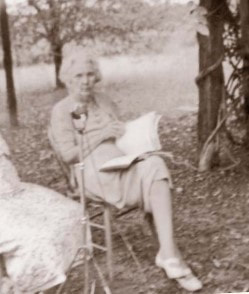| Although currently Ruby Pickens Tartt is remembered mostly as a local legend or by only a small number of academics, in the mid-1940s celebrated folklorist John Lomax heralded her as a “rising celebrity” and a “bright refulgent star” after she broke into a national circle of writers and folklorists by publishing in The Southwest Review and several popular anthologies. Indeed, over the course of many years Tartt opened doors in the world of Alabama’s folk culture that had long remained closed to men such as Lomax. |
During Pickens’s student years, her curiosity about the world beyond her parents’ parlor fl ourished under the tutelage of Julia Strudwick Tutwiler. A progressive educator intent on broadening the horizons of young women, Tutwiler exposed students at the Alabama Normal College, where she served as president, to a life fi lled with “causes” that included prison reform, co-education for women, and temperance. After receiving a degree from Tutwiler’s school, Pickens continued her education at Sophie Newcomb College, where she studied art and English. She then traveled in 1901 to New York, where she enrolled at the Chase School (later known as the New York School of Art) and studied under William Merritt Chase, the leading exponent of American Impressionism.
In 1904 Pickens returned to Alabama, married her childhood sweetheart, Pratt Tartt, and gave birth two years later to the couple’s only child, Fannie Pickens Tartt. But despite the hopes of her parents and in-laws that Tartt might settle down and conform to a conventional life, she had no intention of doing so. Conventional life for an elite white woman in the Black Belt would have meant staying at home, allowing one’s husband to handle public affairs, and accepting the prevailing segregated social order. But Tartt’s confidence in her painting, her delight in storytelling, her disregard for domestic duties, and her frequent visits with members of the local black community quickly proved that she had no intention of being a “proper” southern lady. As a ninety-year-old Tartt would tell fellow folklorist Kathryn Tucker Windham:
“Come to think of it, I was nearly always alone in the enjoyment of my various interests. Therefore I was ‘nuts’ according to public opinion.”
By that point, Tartt had already been working for a number of months collecting the life stories and folk tales of former slaves, under the auspices of the Works Progress Administration. As Tartt later recalled about her family’s circumstances during the Depression, “I found over night in 1936, we not only had no jobs and no money, but we were in debt. …I went all over town and asked if anyone knew of jobs for the most inefficient person on earth. Finally someone suggested I inquire at the Welfare Department, perhaps there was a WPA job I could get.” Ultimately, the WPA provided more than money. Thanks to her position with the agency and Lomax’s repeated visits to Sumter County, Tartt obtained validation for her longstanding interest in folk culture. In 1937 Tartt recorded 305 songs from an area of less than fifteen square miles. In 1939 she and Lomax filled more than twenty disc records (each holding five or six items) for the Archive of American Folk Song at the Library of Congress.
On Lomax’s final trip to Sumter County in 1940, Tartt helped him produce 145 records with more than 750 items for the archive, along with eighty-four photographic negatives of the folksingers.
By the time Ruby Pickens Tartt passed away in 1974 at the age of ninety-four, she had seen civil rights and women’s rights movements capture headlines and transform racial and gender norms in American society. As a white woman who worked among African Americans in the Jim Crow South, Tartt navigated unchartered and sensitive territory long before these revolutions came to pass, and her search for a world where she could assert herself led to art schools in New Orleans and New York, and to museums, libraries, and black churches. From each encounter, she took away words and experiences that helped her articulate an alternative perspective on society. As she once claimed, “Folksongs [and stories] are more than music. They tell us more about the heart of a nation than a hundred history books.”
This feature was previously published in Issue 113, Summer 2014.
About the Author
Tina Naremore Jones is an English professor and dean of educational outreach at the University of West Alabama. Joshua D. Rothman, standing editor of the “Alabama Women” department of Alabama Heritage, is professor of history at the University of Alabama and director of the university’s Frances S. Summersell Center for the Study of the South, which sponsors this department.

 RSS Feed
RSS Feed